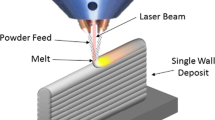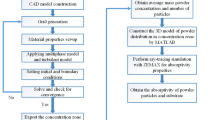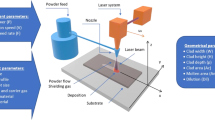Abstract
This paper presents an overview of vertically integrated comprehensive predictive modeling capabilities for directed energy deposition processes, which have been developed at Purdue University. The overall predictive models consist of vertically integrated several modules, including powder flow model, molten pool model, microstructure prediction model and residual stress model, which can be used for predicting mechanical properties of additively manufactured parts by directed energy deposition processes with blown powder as well as other additive manufacturing processes. Critical governing equations of each model and how various modules are connected are illustrated. Various illustrative results along with corresponding experimental validation results are presented to illustrate the capabilities and fidelity of the models. The good correlations with experimental results prove the integrated models can be used to design the metal additive manufacturing processes and predict the resultant microstructure and mechanical properties.



















Similar content being viewed by others
References
Ramani K, Ramanujan D, Bernstein WZ, Zhao F, Sutherland J, Handwerker C, Choi JK, Kim H, Thurston D (2010) Integrated sustainable life cycle design: a review. J Mech Des 132(9):091004
Smith J, Xiong W, Yan W, Lin S, Cheng P, Kafka OL, Wagner GJ, Cao J, Liu WK (2016) Linking process, structure, property, and performance for metal-based additive manufacturing: computational approaches with experimental support. Comput Mech 57(4):583–610
Schoeffel K, Shin YC (2007) Laser cladding of two hardfacing alloys onto cylindrical low alloy steel substrates with a high power direct diode laser. In: ASME international conference on manufacturing science and engineering, 2007MREC-31112, Oct 15–18, Atlanta, GA
Wilson JM, Shin YC (2012) Microstructure and wear properties of laser-deposited functionally graded Inconel 690 reinforced with TiC. Surf Coat Technol 207(25):517–522
Hamed A, Tabakoff W, Wenglarz R (2006) Erosion and deposition in turbomachinery. J Propuls Power 22:350–360
Piya C, Wilson JM, Murugappana S, Shin Y, Ramani K (2011) Virtual repair: geometric reconstruction for remanufacturing gas turbine blades. In: Proceedings of the ASME 2011 international design engineering technical conferences and design for manufacturing and the life cycle conference, IDETC/DFMLC 2011, Aug 29–31, Washington, DC, USA
Wilson JM, Piya C, Shin YC, Zhao F, Ramani R (2014) Remanufacturing of turbine blades by laser direct deposition with its energy and environmental impact analysis. J Clean Prod 80(1):170–178
Rozzi JC, Pfefferkorn FE, Incropera FP, Shin YC (1998) Transient thermal response of a rotating cylindrical silicon nitride workpiece subjected to translating laser heat source: part I—comparison of surface temperature measurements with theoretical results. Trans ASME J Heat Transf 120(4):899–906
Rozzi JC, Incropera FP, Shin YC (1998) Transient thermal response of a rotating cylindrical silicon nitride workpiece subjected to translating laser heat source: part II—parametric effects and assessment of a simplified model. Trans ASME J Heat Transf 120(4):907–915
Rozzi JC, Pfefferkorn FE, Incropera FP, Shin YC (2000) Transient, three-dimensional heat transfer model for the laser assisted machining of a silicon nitride ceramic: part I—comparison with measured surface temperature histories. Int J Heat Mass Transf 43:1409–1424
Rozzi JC, Incropera FP, Shin YC (2000) Transient, three-dimensional heat transfer model for the laser assisted machining of a silicon nitride ceramic: part II—assessment of parametric effects. Int J Heat Mass Transf 43:1425–1437
Pfefferkorn FE, Incropera FP, Shin YC (2005) Heat transfer model of semi-transparent ceramics undergoing laser-assisted machining. Int J Heat Mass Transf 48(10):1999–2012
Tian Y, Shin YC (2006) Thermal modeling for laser-assisted machining of silicon nitride ceramics with complex features. Trans ASME J Manuf Sci Eng 128:425–434
Tian Y, Wu BX, Shin YC (2008) Laser-assisted milling of silicon nitride and Inconel 718. Trans ASME J Manuf Sci Eng 130:031013
Skvarenina S, Shin YC (2006) Predictive modeling of laser hardening of complex surfaces. Surf Coat Technol 201(6):2256–2269
Patwa R, Shin YC (2007) Laser hardening of AISI5150H steels. Int J Mach Tools Manuf 47(2):307–320
Lakhkar R, Shin YC, Krane M (2008) Predictive modeling of multi-track laser hardening of AISI 4140 steel. Mater Sci Eng A 480:209–217
Wen S, Shin YC, Murthy JY, Sojka P (2009) Modeling of coaxial powder flow for the laser direct deposition process. Int J Heat Mass Transf 52(23–24):5867–5877
Wen S, Shin YC (2010) Modeling of transport phenomena during the coaxial laser direct deposition process. J Appl Phys 108:044908
Wen S, Shin YC (2011) Modeling of the laser direct deposition process by a high power direct diode laser. Trans ASME J Heat Transf 133(3):031007
Bailey N, Tan W, Shin YC (2009) Predictive modeling and experimental results for residual stresses in laser hardening of AISI 4140 steel by a high power diode laser. Surf Coat Technol 203(14, 15):2003–2012
Fu YC, Loredo A, Martin B, Vannes AB (2002) A theoretical model for laser and powder particles interaction during laser cladding. J Mater Process Technol 128:106–112,
Han L, Liou FW, Phatak KM (2004) Modeling of laser cladding with powder injection. Metall Mater Trans B 35:1139–1150
Pinkerton J, Li L (2004) An analytical model of energy distribution in laser metal deposition. Proc Inst Mech Eng B 218:363–374
Han LJ, Phatak KM, Liou FW (2005) Modeling of laser deposition and repair process. J Laser Appl 17(2):89–99
Katinas C, Shang W, Shin YC, Chen J (2017) Modeling particle spray for direct laser deposition using a four nozzle powder injection system. In: ASME international conference on manufacturing science and engineering, MSEC2017-2974, June 4–9, 2017, Los Angeles, California
Lin J (1999) Concentration mode of the powder stream in coaxial laser cladding. Opt Laser Technol 31(3):251–257
Lin J (2000) Numerical simulation of the focused powder streams in coaxial laser cladding. J Mater Process Technol 105(1):17–23
Pinkerton AJ, Li L (2002) A verified model of the axial powder stream concentration from a coaxial laser cladding nozzle. In: Proceedings of international congress on applications of lasers and electro-optics (ICALEO’02), Scottsdale, Arizona, U19SA CD
Pinkerton AJ, Li L (2004) Modelling powder concentration distribution from a coaxial deposition from a coaxial deposition nozzle for laser-based rapid tooling. Trans ASME J Manuf Sci Eng 126(1):33–41
Launder BE, Spalding DB (1972) Lectures in mathematical models of turbulence. Academic Press, London
Serag-Eldin MA, Spalding DB (1979) Computations of three-dimensional gas turbine combustion chamber. J Eng Power 101:327–336
He X, Mazumder J (2007) Transport phenomena during direct metal deposition. J Appl Phys 101:053113
Han L, Liou FW, Phatak KM (2004) Modeling of laser cladding with powder injection. Metall Mater Trans B 35:1139–1150
Liu CY, Lin J (2003) Thermal processes of a powder particle in coaxial laser cladding. Opt Laser Technol 35(2):81–86
Han LJ, Phatak KM, Liou FW (2005) Modeling of laser deposition and repair process. J Laser Appl 17(2):89–99
Qi H, Mazumder J, Ki H (2006) Numerical simulation of heat transfer and fluid flow in coaxial laser cladding process for direct metal deposition. J Appl Phys 100:024903
Pinkerton AJ, Li L (2004) The development of temperature fields and powder flow during laser direct metal deposition wall growth. J Mech Eng Sci 218:531–541
Pan H, Liou F (2005) Numerical simulation of metallic powder flow in a coaxial nozzle for the laser aided deposition process. J Mater Process Technol 168(2):230–244
Pan H, Sparks T, Thakar YD, Liou F (2006) The investigation of gravity driven metal powder flow in coaxial nozzle for laser-aided direct metal deposition process. ASME J Manuf Sci Eng 128(2):541–553
Choi J, Han L, Hua Y (2005) Modeling and experiments of laser cladding with droplet injection. Trans ASME J Manuf Sci Eng 127:978–986
Wen S, Shin YC (2009) Modeling of the off-axis high power diode laser (HPDL) cladding process. In: Proceedings of the ASME 2009 international manufacturing science and engineering conference, MSEC2009-84049, October 4–7, 2009, West Lafayette, IN, USA
Tan W, Bailey N, Shin YC (2011) A novel integrated model combining cellular automata and phase field methods for microstructure evolution during solidification of multi-component and multi-phase alloys. Comput Mater Sci 50(9):2573–2585
Wang W, Lee PD, Mclean M (2003) A model of solidification microstructures in nickel-based superalloys: predicting primary dendrite spacing selection. Acta Mater 51:2971–2987
Kim SG, Kim WT, Suzuki T (1999) Phase-field model for binary alloys. Phys Rev E Stat Phys Plasmas Fluids 60:7186–7197
Cha PR, Yeon DH, Yoon JK (2005) Phase-field model for multicomponent alloy solidification. J Cryst Growth 274:281–293
Zhang R, Jing T, Jie W, Liu B (2006) Phase-field simulation of solidification in multicomponent alloys coupled with thermodynamic and diffusion mobility databases. Acta Mater 54:2235–2239
Tan W, Wen S, Bailey N, Shin YC (2011) Multi-scale modeling of transport phenomena and dendritic growth in diode laser cladding process. Metall Mater Trans B 42(6):1306–1318
Bailey NS, Tan W, Shin YC (2009) Predictive modeling and experimental results for residual stresses in laser hardening of AISI 4140 steel by a high power diode laser. Surf Coat Technol 203:2003–2012
Zhao JZ, Mesplont C, De Cooman BC (2001) Kinetics of phase transformations in steels: a new method for analysing dilatometric results. ISIJ Int 41:492–497
Zhao JZ, Mesplont C, De Cooman BC (2002) Quantitative analysis of the dilatation during an isothermal decomposition of austenites. Mater Sci Eng A 332:110–116
Jung M, Lee S-J, Lee Y-K (2009) Microstructural and dilatational changes during tempering and tempering kinetics in martensitic medium-carbon steel. Metall Mater Trans A 40:551–559
Jin L (2001) Simulation of quenching and temperaing of steels. Purdue University, West Lafayette
Bailey NS, Katinas C, Shin YC (2017) Laser direct deposition of AISI H13 tool steel powder with numerical modeling of solid phase transformation, hardness, and residual stresses. J Mater Process Technol 247:223–233
Acknowledgements
The research presented in this paper has been funded by National Science Foundation (Grant Nos: IIP-0538756, IIP-0917936, CMMI-1233783), State of Indiana through the 21st Century R&T Fund, and Industrial Consortium members of the Center for Laser-based Manufacturing.
Author information
Authors and Affiliations
Corresponding author
Rights and permissions
About this article
Cite this article
Shin, Y.C., Bailey, N., Katinas, C. et al. Predictive modeling capabilities from incident powder and laser to mechanical properties for laser directed energy deposition. Comput Mech 61, 617–636 (2018). https://doi.org/10.1007/s00466-018-1545-1
Received:
Accepted:
Published:
Issue Date:
DOI: https://doi.org/10.1007/s00466-018-1545-1




